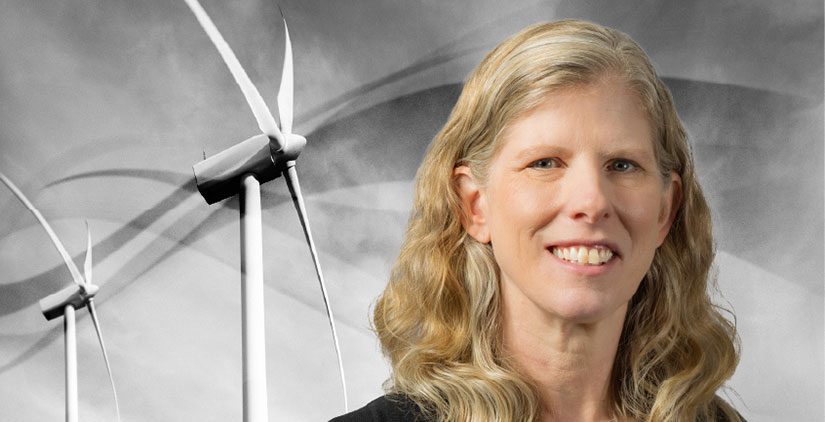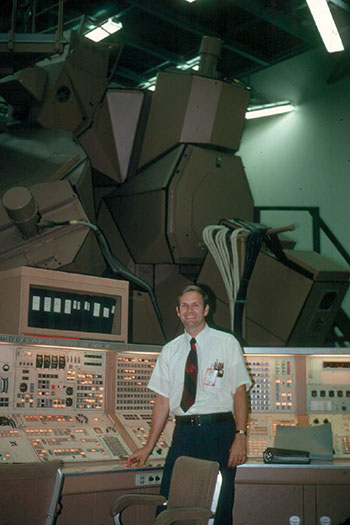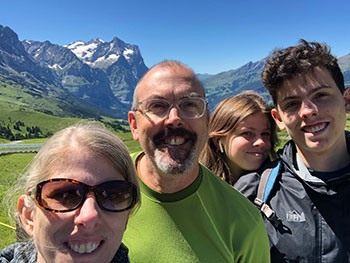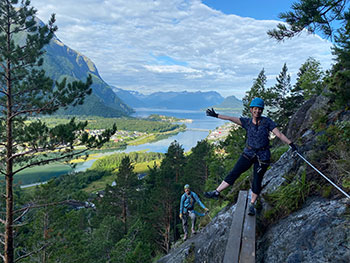Behind the Blades: Amy Robertson Takes On the Complexities of Floating Offshore Wind
A Reluctant Engineer Talks About How She Uses Her Love for a Challenge To Innovate in This Fledgling Field

Amy Robertson joined NREL in 2010 to tackle the emerging field of offshore wind energy. Photo by Werner Slocum, NREL; graphic by John Frenzl, NREL
As a kid growing up in Clear Lake City, Texas, home of the Johnson Space Center, Amy Robertson was immersed in what was happening at NASA. Just about everybody she knew—including her dad—either worked at NASA or had parents who did. So it made perfect sense that, as a kid, she dreamed of joining the space industry.
But not, she emphasizes, as an astronaut. When her dad brought her to work and let her try out the astronaut-training centrifuge, she threw up. And when Alan Shepard visited her classroom and demonstrated how astronauts use the restroom in space, she was officially out. (“Who wants to do that stuff?” Robertson thought.)

Robertson’s father, Claude, worked at NASA for most of his life, as did many of the
people in her orbit as a child. In fact, Robertson’s eighth grade soccer coach, Ellison
Onizuka, was among the astronauts who perished when the Space Shuttle Challenger exploded
in 1986. Photo from Amy Robertson, NREL
Robertson did pursue her space dreams, though, ultimately earning a Ph.D. in aerospace engineering. But the best use of her skills and education seem to be right here on Earth, as offshore wind energy group manager at the National Renewable Energy Laboratory (NREL).
“I was the first person hired at NREL that was devoted to offshore wind,” Robertson said. “But I had no experience in wind! None.”
Luckily, that degree in aerospace engineering came in handy.
“I'm a structural person, and the crazy thing about floating wind is that it's a structures problem," she said. "It's a wind aerodynamics problem, and it's a hydrodynamics problem, too. Finding someone who's an expert in all three is almost impossible.”
So, in 2010, Robertson took her structural experience and her love of a challenge and applied it to the nascent field of offshore wind energy. We caught up with her to find out more about her journey before coming to NREL—and why it has been an exciting ride ever since. This interview has been edited for clarity and length.
First off, how did you decide you wanted to be an engineer?
I never wanted to be an engineer! My dad worked at NASA, first on the Apollo space missions, then in a lead role on the space shuttle missions. So I did want to work in the space program, but at first, I didn’t understand that that would require being an engineer. But I love to study. I love to understand things, and I love structural dynamics. And my parents really wanted me to be an engineer!
So you went off to college for your engineering degree, then liked it enough to pursue both a master’s and Ph.D. What came next?
When I left grad school at the University of Colorado Boulder, there weren’t many jobs in the space industry, so some colleagues convinced me to join them at Los Alamos National Laboratory (LANL). I wasn’t particularly interested in weapons, but I agreed with the idea that we needed a nuclear weapons stockpile, and it needed to be kept safe and functional (otherwise known as stockpile stewardship).
I showed up and was just thrown on all kinds of projects. One day they told me to calculate the structural load of a particular weapons system—without touching it. So I set up speakers and bounced sound off the weapon, then measured the frequencies of the sound to determine the preload. They let me build a whole unique system! It was fun having that much freedom.
But then you ended up back in Boulder not too long after. Why?
In 2000, a few years into my time at LANL, we lost our house in the Cerro Grande fire [a prescribed burn in nearby Bandelier National Monument that got out of control and burned 400 homes]. Without any earthly possessions, my husband and I thought about traveling the world! But both of our employers wanted to keep us on and allowed us to work remotely, so we headed back to Boulder and started over.
A few years later we began having kids, so I left LANL and took up consulting while my son and daughter were young. But after six years of that, I was itching to get back into research.

Robertson—pictured here with husband Greg, daughter Jade, and son Nate in Switzerland in summer 2022—enjoys the outdoors and getting time to hike. Photo by Amy Robertson, NREL
Then the job at NREL in offshore wind energy popped up. What attracted you to the field?
I saw the NREL job and applied and never thought I would even get an interview because I didn’t have much of a wind background! They first hired me to work on structures for fixed-bottom offshore wind turbines, which was in line with my capabilities.
Then this new floating wind project popped up, and they gave me the opportunity to work on that. Floating wind to me is just such an incredibly fascinating topic. It makes for such a complex, crazy problem. At the time, there was only one floating turbine in the world (and there are still fewer than 20 in the world now). So to be at the forefront of a new industry seemed so exciting.
So, now what do your day-to-day activities look like?
As a group manager, I have to wear two hats—always trying to address my team members’ concerns and needs but also continuing to lead research. There’s a project called the Offshore Code Comparison Collaboration, or OC3, that I took over when I started. It's an international research collaborative with the International Energy Agency that helps standardize design and validation processes for offshore wind turbines. I’ve since created OC4, OC5, OC6, and as of January 2024, OC7.
I’m also working on the FLoating Offshore Wind ReadINess (FLOWIN) Prize, the first wind-focused prize administered by NREL, which aims to help floating offshore wind designers and supply chain manufacturers collaborate so that we can build and deploy 100-turbine offshore wind farms more cost-effectively.
Why do you think it’s so important that we pursue floating offshore wind technologies?
So many people live in coastal areas, but you can’t build land-based wind farms in the middle of those congested areas. There’s lots of available space offshore, where the winds are stronger. And with offshore wind you don’t have the transportation constraints of building on land. So you can build them bigger and more cost-effectively, especially if they can be attached to the seafloor. (Listen to an NPR interview with Robertson about all things offshore wind.)
But that’s not viable when you go further offshore. That’s where floating turbines come in. The whole west coast of the United States will require floating offshore wind technologies because there is no shallow water—the continental shelf drops off. That’s why we should be a leader in floating technologies. It’s what we’ll need most.
You’ve been at NREL longer than anywhere else in your career. What keeps you here?
I finally found the right fit—a combination of being passionate about the work we do, the impact that we're having on renewable energy and climate change, coupled with the complex engineering problem that we're trying to solve, and being at the forefront of this industry. And that’s in addition to the wonderful people we're working with here. Being a manager is so much easier because of that. I mean, I know everyone's doing their job because they're passionate about their work!
I love the outdoors, so if I have time, I walk our wind turbine loop [at NREL’s Flatirons Campus, just south of Boulder, Colorado] at lunch. And Thursday barbecues! Everyone who works at the Flatirons Campus, even if they don’t come in every day of the week, always comes for the barbecues. It’s a good chance to get to talk to everyone that you don't see throughout the week and meet new people.
You said you love the outdoors. Is that an important part of your downtime? Anything else you do when you want to turn your brain off?
I love hiking. That's the number-one thing I enjoy.
But because floating offshore wind doesn’t exist in the United States, I have to travel a lot. For me, there was a silver lining to the COVID lockdown—it forced me to stop traveling for a while. During that time, my son and I went on daily hikes together and we were really able to bond. My son is in college, and so now I’m holding on to the time I have left with my daughter before she goes off to college.

Robertson’s family traveled around Norway in summer 2023, challenging themselves on via ferratas, like Romsdalsstigen, seen here. Photo from Amy Robertson, NREL
And I wish I could turn my brain off! When my kids were young, I went out and played bridge. Now I play online with friends. I’d say everyone I play with that’s under the age of 80 is an engineer. It’s that analytical brain!
Any advice for students interested in a career in wind energy?
First of all, I say if you're interested in wind energy, go for it! It's so cool. I mean, not to be biased, but I don't know of a cooler thing to study than offshore wind. Start looking for college courses that would help build the foundational knowledge you’ll need, then find internship opportunities. We hire interns left and right!
Learn more about NREL’s offshore wind energy research and the other amazing people behind the blades by subscribing to the Leading Edge newsletter.
Last Updated May 28, 2025
